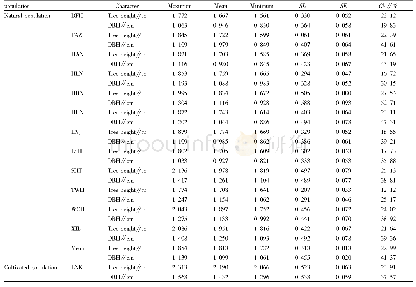《Table 3 Self-pollination and open pollination fruiting rates of superior individual of L.caerulea》下
 提示:宽带有限、当前游客访问压缩模式
提示:宽带有限、当前游客访问压缩模式
本系列图表出处文件名:随高清版一同展现
《Study on Pollination Compatibility of Superior Lonicera caerulea Individuals》
In order to investigate the self-compatibility,pollination habit and open pollination fruiting rate of superior L.caerulea individuals,this study designed three treatments:direct bagging,bagging following pollination(selfing)and open pollination,and the results are shown in Table 4.It could be seen from Table 4 that the three superior individuals all had self-pollination fruiting rate of 0 in the direct bagging treatment;and the bagging following pollination treatment had the self-pollination fruiting rates of 0,100%and 85%for the three superior individuals,respectively.In the experimental process,it was found that L.caerulea pollen had a higher sugar content,and the pollen was attached to the anther shell,not prone to falling,and even difficult to dipped with a pollenator.It could thus been that it is difficult for wind to blow pollen off,and therefore,L.caerulea only could depend on entomophilous pollination.Because L1 is completely self-incompatible,it is necessary to plant a certain amount of pollination trees or plant it together with multiple species,to improve its yield.On the contrary,L2 and L3 have no need for pollination trees theoretically,but whether the fruits obtained by self-pollination and outcrossing differ in quality still needs further study.It could be seen from Table 4 that the open pollination fruiting rates of the three individuals in mixed form were 94%,96%and 98%,respectively,suggesting that different L.caerulea individuals have good pollination compatibility therebetween,and could serve as a pollination tree mutually.
| 图表编号 | XD00183110500 严禁用于非法目的 |
|---|---|
| 绘制时间 | 2018.10.01 |
| 作者 | Mengjing SUN、Hounan CAO、Yu YAO、Yujun SHENG、Chengwen ZONG |
| 绘制单位 | Department of Horticulture and Landscape,College of Agriculture,Yanbian University、Department of Horticulture and Landscape,College of Agriculture,Yanbian University、Department of Horticulture and Landscape,College of Agriculture,Yanbian University、Depart |
| 更多格式 | 高清、无水印(增值服务) |
查看“Table 3 Self-pollination and open pollination fruiting rates of superior individual of L.caerulea”的人还看了
-

- Table 3 Statistical results on the growth characters of open-pollinated progenies from natural populations
-

- Table 6 Analysis of variance components and genetic gains of growth characters from open-pollinated progenies





